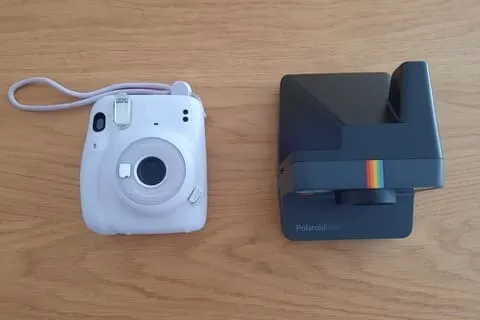Digital cameras are all the rage nowadays. But, despite that, there’s something irresistible about the 80s feels of instant photography that we can’t shake off. So which instant camera should you pick to get the ultimate balance of vintage and modern?

We now have two top instant camera contenders: the Polaroid Now vs Instax Mini 11. Are you curious about how this showdown goes? Read on to pick your favorite winner.
Comparing The Two Instant Cameras
Generation X babies will never miss an opportunity to brag about the Polaroid Originals they grew up with, despite parting with them in the early 2000s.
On the other hand, millennials will tell you that’s when the leading digital publisher Fujifilm’s Instax film started dominating the instant photography scene.

In a way, the comeback of the Polaroid from Impossible Project and the Instax cameras from Fujifilm can be considered a showdown between Generation X’s and the Millennials idols.
Whether you’re an avid fan of the instant film or curious about the latest models, here’s everything you need to know about the Polaroid Now and Instax Mini 11.
Design
Polaroid Now has the same retro vibe as the Polaroid Go, with its boxy camera body and sharp edges. Aside from housing fewer buttons, you’ll feel nostalgic since it hasn’t changed much from its earlier models.
Around the lens at the front, you’ll find the shutter and self-timer buttons and the flash.
The Polaroid film comes out from below, while the viewfinder extends to the back to better accommodate the user. You’ll also find the flash, power buttons, and LED film counter on the back.
The Instax Mini 11 sports a cute, curvy body that matches its youthful and modern vibes. You’d almost mistake it for a toy if not for the expert lens and the developed film that comes out the top.

You can see how this camera is mainly targeted toward teens and millennials from its youthful design, bright colors, and cute accessories.
With every Instax Mini 11, you’ll get a hand strap and a jewel button made of rubber to make the shutter button smoother to the touch.
In short, the main difference between the two models is that they target two different customer segments.
The first gives off solid retro vibes that will satisfy Polaroid Original’s loyalists, while the latter matches the modern style with its pastel colors and fancy accessories.
Specs
With the Onestep, you had to switch between landscape and portrait settings manually, but that changed with Polaroid Now. The camera features a nifty autofocus feature that automatically switches between the two modes.
That comes from its ability to recognize objects and switch between the 35mm and 40mm lenses, although its accuracy can still be improved.
If there’s one bad piece of news, you can no longer use Bluetooth connectivity and select different shots or modes using your phone. You’re better off using an instant digital camera for that.
Although you can set a selfie-timer, there’s no selfie mirror. It’ll take trial and error until you can master the selfie mode for individual and group shots.
You can use classic 600 films or modern Polaroid i-Type films with Polaroid Now.
Its film size is bigger than Instax Mini 11 and Instax Wide film packs, giving you more freedom to hang or add them to a scrapbook. Although the Instax Wide film is available, you can’t use it instead of the Instax Mini film.
Unlike the Instax Mini 90, Instax Mini 11 has forgone the tripod socket, although that won’t matter much since you can set the camera vertically on its flat bottom. You can read my Instax Mini 90 vs Mini 11 review for an in-depth comparison.
Battery and Charging
Charging the Polaroid Now is straightforward with its built-in rechargeable battery. You can charge it by connecting the supplied USB-A cable to its Micro-USB port. One recharge can last you up to 15 to 16 film packs.
The Mini 11 still uses two AA batteries like the previous Instax models. A single pack can last you around ten film packs or 100 shots.
Remember to use Alkaline batteries for all the Fujifilm Instax Mini models. Otherwise, you may experience the LED indicator glitching or refusing the turn on.
Photo Quality and Performance
The new Polaroid has upgraded its built-in flash to be stronger and brighter than its predecessors, the OneStep 2 or Polaroid Go. Its flashlight ensures accurate color reproduction, so you won’t have to worry about getting overexposed photos.
The Instax Mini flash still has room for improvement, as it tends to over-brighten the images.
Both cameras have a neat autofocus feature that gives decent photos, though you’re in the wrong place if you expect DSLR-like quality. After all, both are entry-level instant cameras suitable for beginners and amateurs.

The most remarkable thing about Polaroid Now is its double exposure mode. If you press the selfie-timer button twice, you’ll dramatically affect your shots.
Although its exposure controls are better than other Instax cameras, the Instax Mini 11 has no double exposure feature.
Unlike Fujifilm Instax Mini 90, its exposure control is fully automatic, so you won’t be able to adjust the brightness.
The way the two models develop photos is fundamentally different. A Polaroid picture takes 10 to 15 minutes to develop, while Instax Mini 11 only takes a few minutes.
Polaroid Now vs Instax Mini 11: At A Glance
| Camera Model | Polaroid Now | Fujifilm Instax Mini 11 |
| Printing Method | Film | Film |
| Picture Size (without border) | 3.1” x 3.1” | 2.4” x 1.8” |
| Picture Size (with border) | 4.2” x 3.5” | 3.4” x 2.1” |
| Picture Format | 1:1 | 3:2 |
| Paper Capacity | 15 | 10 |
| Film Type | Polaroid Originals i-Type, Polaroid 600 | Instax Mini Instant Film |
| Film Developing Time | 10 to 15 minutes | 90 seconds |
| Flash | Yes | Yes |
| Deactivate Flash | Yes | No |
| Focal Length | 94.96 – 102.35mm | 60mm |
| Focus Type | Zone Focus | Fixed Focus |
| Minimum Focus Distance | 1.80′ / 55 cm | 11.81″ / 30 cm |
| Viewfinder Type | Optical | Optical |
| Exposure Mode | Automatic | Automatic |
| Selfie Mirror | No | Yes |
| Self-Timer | Yes | Yes |
| Battery and Charging | Micro-USB | 2 x AA batteries |
| Shots per Charge | Approximately 120 | Approximately 100 |
| Tripod Mount | No | No |
| Dimensions | 3.7″ x 4.4″ x 5.9″ | 4.24″ x 4.77″ x 2.65″ |
| Weight Without Film Pack | 0.95 lb | 0.65 lb |
| Warranty | Limited 1-Year Warranty | Limited 1-Year Warranty |
| Beginner-Friendly | Yes | Yes |
| Buy from Amazon | Polaroid Now Amazon link | Mini 11 Amazon link |
FAQs
Is Instax Mini or Polaroid 11 Better?

The final choice comes down to you. Both instant cameras are affordable, beautifully designed, and produce quality images. However, it’s undeniable that Polaroid Now has higher performance and gives better photo quality on a wide film. It has better focus, although not strong enough for macro shooting.
That said, it’s better to start with the Fujifilm Instax Mini 11 if you’re a beginner testing out the grounds of instant photography. Instax Mini films are much more affordable than Polaroid’s, and its exposure feature is better than Fujifilm Instax Mini 90.
What Is The Difference Between Instax and Polaroid?

Although instant photography has long been associated with “Polaroid,” Instax and Polaroid are two entirely different brands. Instax is an instant camera branch created by Fujifilm. Before Instax Mini 11, there was Fujifilm Instax Mini 90, 8, and even the 1998-model Instax Mini 10. Meanwhile, Polaroid is the name of the original brand that’s long been renowned for its cult cameras.
In short, the main difference between modern instant cameras lies in the histories of both brands. While Polaroid represents retro and old-school, Fujifilm Instax portrays modernity and individuality.
How Can I Create Great Photos Using An Instant Camera?

Using an instant camera is entirely different than using a digital camera. It’ll take trial and error until you get used to the instant analog camera. First of all, make sure you give as much light as possible. You can always use flash with the Polaroid now – Polaroid cameras love light.
However, using the Instax Mini in adequate light may lead to overexposure. Keep your instant camera steady while shooting. Half-press the shutter button to focus on your subjects, then fully press it to change the photo’s composition.
Why’s My Instax Mini Film Coming Out Blank?

Your Instax Mini film might be coming out blank due to several reasons: (1) expired or damaged film due to light exposure, (2) improper loading of the film cartridge, (3) camera lens obstruction, or (4) insufficient light when taking the photo. Ensure your film is not expired, stored away from light, properly loaded, and the lens is clear, while also providing adequate lighting when capturing images.
Why Hasn’t The Film Developed Properly?

Make sure to keep the film steady after taking the picture. Avoid shaking, squeezing, or creasing it when it’s developing to avoid disturbing the proper distribution of film chemicals. However, some people intentionally do so for more creative shooting modes!
Why Does My Film Get Jammed While Ejecting From The Camera?

A lot of power is used to eject the film. So if that happens, you should first suspect a low battery. In that case, you should replace or recharge the batteries while the lens is opened.
Instax Mini 11 vs Polaroid Now: My Verdict
Despite all the advancements in the digital camera world, you’ll be hard-pressed to find someone who doesn’t enjoy using instant cameras. There will always be a long-standing rivalry between Polaroid vs. Instax fans.
While the Polaroid Now and Instax Mini 11 each have unique features and produce different quality, they both provide a wholesome experience of developing instant photos. In short, they’re two of the best instant cameras for kids you can get your hands on.